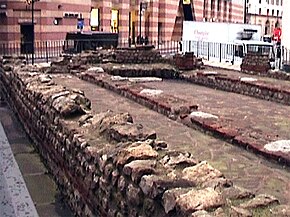Temple of Mithras, London

The Mithraeum in 2004 when reassembled at Temple Court, Queen Victoria Street, EC4
|
|
| Location | 12 Walbrook, London, EC4N 8AA |
|---|---|
| Coordinates | 51°30′45.6″N 00°05′30″W / 51.512667°N 0.09167°WCoordinates: 51°30′45.6″N 00°05′30″W / 51.512667°N 0.09167°W |
| Type | Sanctuary |
| History | |
| Periods | Roman Imperial |
The London Mithraeum, also known as the Temple of Mithras, Walbrook, is a Roman mithraeum that was discovered in Walbrook, a street in the City of London, during a building's construction in 1954. The entire site was relocated to permit continued construction and this temple of the mystery god Mithras became perhaps the most famous 20th-century Roman discovery in London.
The site was excavated by W. F. Grimes, director of the Museum of London, in 1954. The temple, initially hoped to have been an early Christian church, was built in the mid-3rd century and dedicated to Mithras or perhaps jointly to several deities popular among Roman soldiers. Then it was rededicated, probably to Bacchus, in the early fourth century. Found within the temple, where they had been carefully buried at the time of its rededication, were finely detailed third-century white marble likenesses of Minerva, Mercury the guide of the souls of the dead, and the syncretic gods Mithras and Serapis, imported from Italy. There were several coarser locally-made clay figurines of Venus, combing her hair. The artefacts recovered were put on display in the Museum of London.
Among the sculptures the archaeologists found was a head of Mithras himself, recognizable by his Phrygian cap. The base of the head is tapered to fit a torso, which was not preserved.
Artefacts found in Walbrook in 1889 probably came from the Mithraeum, according to the archaeologist Ralph Merrifield, although this was not identified at the time (Merrifield 1965, p. 179). One was a marble relief, 0.53 m tall, of Mithras in the act of killing the astral bull, the Tauroctony that was as central to Mithraism as the Crucifixion is to Christianity. On it Mithras is accompanied by the two small figures of the torch-bearing celestial twins of Light and Darkness, Cautes and Cautopates, within the cosmic annual wheel of the zodiac. At the top left, outside the wheel, Sol–Helios ascends the heavens in his biga; at top right Luna descends in her chariot. The heads of two wind-gods, Boreas and Zephyros, are in the bottom corners. It bears the inscription
...
Wikipedia

